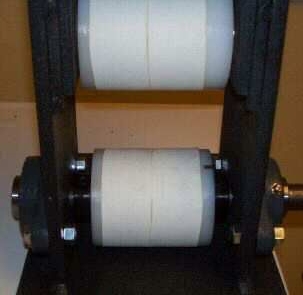
|
Physics and Acoustics of Baseball & Softball Bats
Daniel A. Russell, Ph.D. Graduate Program in Acoustics The Pennsylvania State University The contents of this page are ©2009-2011 Daniel A. Russell | 
|

|
Physics and Acoustics of Baseball & Softball Bats
Daniel A. Russell, Ph.D. Graduate Program in Acoustics The Pennsylvania State University The contents of this page are ©2009-2011 Daniel A. Russell | 
|
As an example of how seriously associations are taking this issue, the ASA recently changed their bat certification policy. When the ASA certifies a bat as passing its 98-mph Batted-Ball Speed standard, that bat is expected to pass the standard forever, even after being broken-in. As of October, 2007 all composite bats are now being artificially broken-in using a barrel rolling technique before they are sent to the Sports Science Laboratory at Washington State University to be performance tested for certification. I'm not sure what it means for the future of ASA softball, or for the future of composite bats, but at the end of January, 2008, only one composite bat (including all 2007-2008 composite bat models that had previously been certified "out of the wrapper") has passed the 98-mph ASA cerfication test after being broken in by rolling. I would expect to see some changes in the design of composite bats in 2009 in accordance with the ASA policy change.
Breaking News (July 17, 2009): On July 17, 2009 the NCAA published a memo to all athletic directors, conference commissioners and head baseball coaches announcing that the NCAA Baseball Ball Rules Committee is proposing an "immediate and indefinite moratorium banning the use of composite barrel baseball bats." This meratorium proposal will be considered and voted on by the Playing Rules Oversight Panel later this summer. The proposal is a response to research collected during the 2009 Divsion 1 Baseball Championship. The composite bats used by players during the championship were subjected to compliance testing with the current BESR standard, and 80% of the bats (all of which were bat models that had been certified as passing the BESR test off the shelf) were found to exceed the BESR performance standard. During the last two years there has been also been an increase in batting averages and home run production. These results suggest that the performance of composite bats increases due to repeated use and/or accelerated break-in techniques (or bat modification). The NCAA is seriously considering this meratorium on composite bats because they consider it their responsibility to watch out for the safety of players and because they want to maintain the integrity of the game.
How Much Does a Composite Bat's Performance Improve as it is Broken-in?By how much might a typical bat improve with use? A recent Master's Thesis from the Washington State University[1] studied the performance of composite slow-pitch softball bats and the performance improvements gained through various ways a bat might be modidified. The bar chart at right shows test results[1,2] for three bats that were broken-in naturally by hitting balls. Bats JN05 and JE04 are multi-walled composite bats and JA05 is a multi-walled aluminum bat. First, the bats were performance tested brand new, right out of the wrapper, in accordance with the high-speed cannon test (ASTM F2219) used by the ASA to certify bats. Then each bat was used to hit ASA certified 0.44 COR 375lb softballs 500 times in an indoor batting cage. Balls were pitched slow-pitch style, and batters were experience amateurs. After 500 hits the bats were performance tested again. Then another 500 hits and another performance check, and so on until 2000 hits were accumlated.The results in the bar graph show that all three of the bats showed noticeable improvement of 2.5-3.5 mph in batted-ball speed after the first 500 hits, followed by a slight decrease in performance after 1000 hits. The experimental evidence seems clear - the performance of a bat can improve significantly after the bat has been broken in naturally by using it to hit balls. What does a 3.5mph increase in batted-ball speed mean in terms of performance? The difference between a softball leaving a bat at 98-mph and a softball leaving a bat at 101.5-mph is about 27 feet in distance travelled. That could very easily be the difference between a pop fly to the outfield and a homerun. This improvement after break-in poses a problem for associations with bat performance standards and certification. All three bats started out meeting the 98-mph criteria (although the JN05 bat was pushing the limit) when tested brand new. However, after 500 hits, all three bats are now above the 98-mph threshold. The ASA requires that a bat pass the certification test at any time during its useful life. So, from the ASA viewpoint, these bats three bats are no longer legal bats after they have been broken in. This is largely why the ASA has moved to begin breaking in bats prior to sending them out for certification testing - and why very few composite bats are able to pass the 98-mph certification performance standard after being broken-in. |

|
After perusing several websites and discussion boards, it is apparent that there are several popular methods of acclerating the break-in process. Below I'll describe some of the more popular techniques, discuss some data showing how effective they are, and then I'll offer some comments on the issue of whether advanced break-in techniques should be considered bat doctoring techniques.
RollingOne of the most popular ABI techniques is bat rolling. The technique of rolling the bat involves inserting the bat between two rollers, using a press to squeeze the rollers together, and pushing the bat back and forth between the rollers. This squeezes the barrel of the bat enough that the composite fibers and the bonds between the multiple layers making up barrel walls are physically broken. This decreases the stiffness of the bat walls and increases the trampoline effect. Most rollers put the bat long-ways between rollers. The photo below right shows a screen grab from a YouTube video showing a bat roller that runs the rollers parallel to the bat length.The photographs of two rolling devices at right were taken from website of individuals who advertise their services on eBay. Some people put tape on the rollers in an attempt to conceal the marks that are typically left on the barrel as a result of rolling it. The ASA is currently using a similar rolling device to break-in bats prior to sending them out for certification testing to see if they pass the 98-mph performance standard. Almost every single composite bat model from 2007-2008 failed to pass the 98-mph test after being rolled, which means that a rolled bat is no longer legal for play in an ASA sanctioned game.
|
 
|
Barrel Compression Technique (BCT)A second popular technique involves applying compression to squeeze the barrel of the bat, but without rolling. The photograph at right is from an eBay auction (November 2006) in which a guy was auctioning off his bat compression services. It looks like he built a portable hydraulic barrel compression device that he can operate from the back of his truck. In December 2006 I received a letter from another person offering me his services with a special technique for compressing composite bats (developed by some friends of his who handle composite materials) which involves a specially shaped compression surface, rotating the bat at 60o intervals around the circumference and heating the bat walls between each compression.On discussion boards I have seen some debate regarding the use of heat. Just like the rolling process, the reason that this compression technique succeeds in improving bat performance is because the barrel is squeezed enough that the fibers and bonds between the layers in the composite material are broken. The barrel wall of this broken-in bat has decreased stiffness - and thus increased flexibility - and therefore the trampoline effect is greater. Composite materials become soft at high temperatures (ie, greater than 170oF), so the use of heat would allow the barrel to compress more easily, which would allow it to squeeze without breaking the fibers and bonds. Then when the bat barrel cools off, it would return to its pre-squeezed condition and the benefit of squeezing would be lost.
|

|
Compressing the Bat Barrel in a ViseThis is the cheap version of the Barrel Compression Technique. I have seen several advertisements for vising services on eBay, some using normal vise grips, other using special compression machines. There are variations in the specific methods used, but the basic process involves compressing the barrel of the bat by approximately half an inch at equally spaced intervals around the circumference of the bat barrel, using some kind of padding to reduce marking the bat surface. The problem with squeezing a bat in a vise is that it causes severe damage to the bat walls, and greatly reduces the durability of the bat. This may increase the performance for a short while, but it will drastically shorten the life of the bat, and the bat will probably crack or shatter after a few good hits.The photos at right, were taken from webpages and eBay auctions posted by bat doctors offering their services, show two composite bats being compressed in a vise grips. What I cannot figure out is why anyone in their right mind would want to risk damaging an original max-load Miken Ultra by squishing it in a vise. The max-loaded Ultra was such a hot bat to begin with, I cannot imagine why anyone would feel the need to risk destroying it in an attempt to make it even hotter. The same is true for the Easton Synergy - if this was a first batch production run it was already a very hot bat. If you are going to risk damaging a bat in a vise in an attempt to speed up the break-in process, at least do it for a lower performance bat. Again, the thing to realize is that when you put a composite bat in a vise and squeeze it you are actually breaking the fibers (not just stretching them) and the composite layers of material that make up the barrel walls, reducing the durability of the bat and shortening its life.
|


|
Hammer/Mallet TreatmentThe Hammer/Mallet technique is often used by players on their own bats. As the name implies it simply involves hitting the barrel of the bat with a hard rubber mallet, or a ball mallet made by fixing a softball to a handle. There is even a commercially available Bat HammerTM for breaking in bats. One strikes the barrel of the bat along the entire length of the barrel, and around its circumference. The strength of an impact that a player can impart with a rubber mallet is nowhere near the force of impact between bat and ball (unless you can generate several thousand pounds of force), so this technique does not cause damage to the bat barrel like the other techniques mentioned above. I have tested several bats that were broken-in with the Bat HammerTM and have detected a noticeable improvement in performance without the degredation in durability.
|


|
 Bat Doctoring is an illegal modification of the inertial and/or elastic properties of a bat either by end-loading the bat or by shaving the barrel to make the walls thinner. Such alterations modify the physics structure of the bat from its copyrighted and certified state, and as a result are illegal. The ASA and USSSA have adopted rather hard stances against bat doctors, who modify the characteristics of a bat in order to improve its performance. The ASA has successfully won lawsuits in the amounts of $100,000 against two bat doctors and is pursuing legal action against several others. Proponents of ABI processes argue that these techniques should not really be classified as bat doctoring since the structure or appearance of the bat is not really being altered, and the end result is supposedly equivalent to simply putting several hundreds of hits on a bat. One could argue that accelerating the break-in process is not a structural modification, but are merely a means of speeding up a process that happens naturally as a bat is used.
Bat Doctoring is an illegal modification of the inertial and/or elastic properties of a bat either by end-loading the bat or by shaving the barrel to make the walls thinner. Such alterations modify the physics structure of the bat from its copyrighted and certified state, and as a result are illegal. The ASA and USSSA have adopted rather hard stances against bat doctors, who modify the characteristics of a bat in order to improve its performance. The ASA has successfully won lawsuits in the amounts of $100,000 against two bat doctors and is pursuing legal action against several others. Proponents of ABI processes argue that these techniques should not really be classified as bat doctoring since the structure or appearance of the bat is not really being altered, and the end result is supposedly equivalent to simply putting several hundreds of hits on a bat. One could argue that accelerating the break-in process is not a structural modification, but are merely a means of speeding up a process that happens naturally as a bat is used.
Perhaps the question could be addressed by comparing the actual amount of performance enhancement resulting from the ABI techniques discussed above. Accelerated break-in techniques can be very effective at improving the performance of a bat, especially the barrel compression technique. The bar chart at right shows data from a Master's Thesis at Washington State University[1] that investigated the effects of various bat modifications. A collection of composite slow-pitch softball bats were tested using the ASTM F2219 high speed cannon test used to measure batted-ball speed in the laboratory. The bats were then sent away to various bat doctors who used their accelerated break-in techniques on the bats. After being broken in the bats were again tested using the ASTM F2219 98-mph BBS performance test. The bar graph at right compares the before and after results.
Improvement was gained for all techniques, but the BCT process improved the batted-ball speed by 8-9 mph. Recalling that the performance improvement due to natural break-in processes is only about 3 mph, it is difficult to argue that an accelerated break-in process such as BCT is not equivalent to bat doctoring. A process that provides three times the improvement in performance as natural break-in seems to me to be a significant alteration of the bat's performance.
Whether or not ABI techniques are considered as doctoring or not, the advantage gained might disappear in coming years. The ASA currently uses a rolling ABI technique for all new composite bats prior to sending them out for certification testing. Since almost all of the 2007-2008 composite bat models failed to pass the 98-mph certification test after being rolled, I would not be surprised to see some changes in the design of ASA certified composite softball bats for 2009. New bat models will have to be designed so that even after being broken-in they still pass the 98-mph standard. At that point, ABI techniques might not be considered illegal since they would not enable a bat to exceed the required performance limit, but they might enable a player to get their bat to its maximum performance sooner - though at the possible risk of shortening the useful life of the bat.
Back to Physics and Acoustics of Baseball & Softball Bats